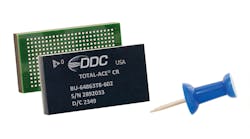Officials of the U.S. Defense Advanced Research Projects Agency (DARPA) in Arlington, Va., are awarding contracts to the three cyber teams as part of the agency's Edge-Directed Cyber Technologies for Reliable Mission Communication program, better-known as EdgeCT.
The contractors for this program are Applied Communication Sciences (ACS) in Basking Ridge, N.J., with partners Apogee Research LLC in Arlington, Va., the Massachusetts Institute of Technology (MIT) in Cambridge, Mass., the University of Pennsylvania in Philadelphia, and Texas A&M University in College Station, Texas; Raytheon BBN Technologies in Cambridge, Mass.; and University of Southern California (USC) in Los Angeles.
The Applied Communication Sciences team won an $11.8 million contract on Wednesday; Raytheon BBN won a $12.2 million contract on Wednesday; and USC won a $4.5 million contract last week.
The EdgeCT contractors will develop systems with real-time network analytics, holistic decision systems, and dynamically configurable protocol stacks.
Related: DOD cyber security strategy to focus on defending military and national-interest networks
Network analytics will find useful information about forward-deployed tactical networking groups by watching packet flows into and out of the network. Holistic decision systems will use this information to fix damage from cyber attacks and network failures. Dynamically configurable protocol stacks, meanwhile, will help fix network damage by changing how the network handles information.
Today's military depends on networked communications -- particularly at the forward-edge of the battlefield -- to coordinate intelligence gathering and attacks on the enemy, as well as for situational awareness.
The wide-area network (WAN) that supports tactical networking to the edge, however, is vulnerable to cyber attacks and network failures that can bring down communications at the worst possible times, DARPA officials explain.
Recovery from cyber attacks and network failures, moreover, can take tens of minutes to hours, while warfighters can tolerate network outages lasting only minutes, if that long.
To strengthen tactical network cyber defenses, the DARPA EdgeCT contractors will focus on three technical areas: EdgeCT systems; experimental lead and evaluator; and voice of the offense.
EdgeCT systems involves an integrated system with real-time network analytics, holistic decision systems, and dynamically configurable protocol stacks.
Experimental lead and evaluator involves an experimental platform that will function as a common, shared experimental environment. Voice of the offense, meanwhile, involves aggressive reviews to uncover potential design weaknesses and vulnerabilities.
The Applied Communication Sciences (ACS) team has proposed a new kind of edge-directed network adaptation called Distributed Enclave Defense Using Configurable Edges (DEDUCE), which incorporates new ways of sensing, actuation, and control in a scalable system that evolves in response to changes in the network.
Related: DARPA to keep military communications open with floating optical fiber and networking buoys
DEDUCE analytics process observations from user application packets traveling to and from edge enclaves to infer WAN characteristics needed for high-quality decision making, such as differentiating between congestion and non-congestion packet loss.
Simultaneously, DEDUCE employs tight-loop runtime control and observation to react and adapt flow treatments quickly in response to network cyber attacks or failures. Its dynamically configurable protocol stacks use several actuators that mitigate the effects of attacks and failures.
Raytheon BBN, meanwhile, will use the company's Intrinsically Resilient Overlay Network (IRON), which is a gateway-based solution that improves the performance of applications that must exchange information between security enclaves over a wide-area network during faults, misconfigurations, and cyber attacks.
The IRON nodes located in each enclave seek to make the most of network utility using stochastic network optimization (SNO) -- a mathematically low-overhead, distributed optimization approach. BBN will extend SNO to achieve practical dynamic management of elastic and inelastic traffic on overlay networks, including traffic with transfer deadlines.
For more information contact Applied Communication Sciences online at www.appcomsci.com, Raytheon BBN Technologies at www.raytheon.com/ourcompany/bbn, University of Southern California at http://itp.usc.edu, or DARPA at www.darpa.mil.



